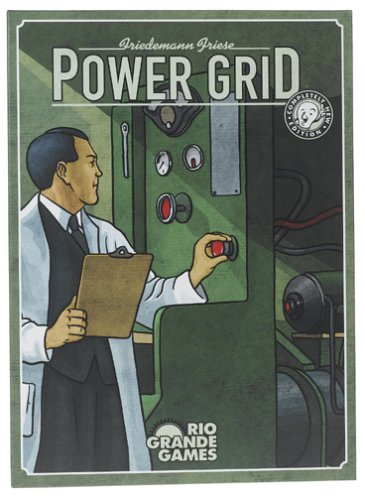San Juan at an initial glance appears to have a myriad of strategic decisions but what is often learned after just a few plays is that it is a game of two primary strategies, with a distinct selection of sub-strategies.
The idea that there is simply two primary routes in San Juan is initially a concern for lack of variety but in reality San Juan simply has an early demand on players to pick a strategy and run with it. I have always felt San Juan requires the ability to play both the "purple buildings" strategy and the "production buildings" strategy although in order to play either optimally one must adapt to cards dealt and play whichever strategy presents itself first.
While San Juan has some awesome cards with neat abilities, it comes as no surprise it is a game about victory point and key action selection. While I can't get into everything here, I have some tips which are the primary themes while executing the expanded ideas below (focusing on three or four player):
- We are aiming for at least 35 points. You can win San Juan with fewer and you can lose with more, but 35 points often puts you in a comfortable spot.
- What we build needs to either be VP/cost efficiency of 2/3 or better (Archive is 1/1, Tobacco Storage is 2/3) or offer a cost savings/income increase that will pay for itself within a few rounds (Quarry or Smithy with -1 cost reduction). We have 12 investments to select and we're looking for a good return on investment and/or quick payback period.
- Role selection is optimal early in the game in this order: Prospector, Builder, Councillor, Producer/Trader. This is probably commonly how it plays out but selecting producer/trader is drastically inefficient unless you have several silver smelters.
- With rare exception I will usually pass on the first build opportunity, this game is not about building your 12th building, its about having the most points when someone else does. I'm aiming to finish with 10 or 11 buildings although if a good combination of cards (explained below) come in succession it is possible to finish first with a large margin of victory due to superior income flow throughout the game. Try not to fall behind by more than two buildings to anyone as it is very difficult to stay within range.
"The City Hall Strategy"
Our first strategy is the more grandiose and technical to execute, but has more potential secondary strategies available. Our key opportunity cards here are the Carpenter and Quarry.

I find this to be the most desirable combo in the game, as you can build several of our other VP/cost efficient cards such as the
Gold Mine,
Archive and
Smithy without a quantity change to your hand. This enables you to select an alternate role selection such as Prospector or Councillor and still build when others select Builder. If dealt both, pass on building until you can build one without having to discard the other. The
Carpenter is slightly better than the
Quarry overall, but I'll never complain about having one over the other. The Carpenter is still worth building late in the game while Quarry is not.
Ideally we can build either of the Carpenter/Quarry early (skipping the first build opportunity to preserve options) and add the other at some point later in the game. At this point we are increasing our hand by looking for the low cost, points efficient cards listed above below in order to keep up with the pace of building while positioning ourselves better than our opponents via greater options.
Gold Mine is one of the best cards in the game as it often will pay for itself several times over in the game. The Archive is nice but here for the low cost and VP ratio. I realize the Smithy seems out of place as we don't intend to build any production buildings once we've selected our purple building path, but it is cost efficient and an easy build if it comes up in your hand.
The Prefecture, Tower and Market Hall are the next layer of this strategy. The Prefecture is an excellent piece of the puzzle, as it doubles our income from one of the frequently selected roles each turn, whether we select it or (hopefully) not. The tower is included here as it is efficient and with our selective approach to building, the income will be rolling in and the last thing we want to do is discard down to seven at the end of the round (a devastating offense in San Juan).
The Chapel is one of the secondary strategies in San Juan, although it has two prerequisites to make full use of it:
- A hand of at least 4 cards that is growing each turn even as you are building, making this an alternative to the Tower.
- A slower game pace in which players are building less frequently and with more efficiency (this is how you can beat an opponent using the very same build order I am listing here).
Keep in mind using the Chapel comes second to actually building each round, if your hand runs low don't utilize it as you may be a card short on building next turn. Even if you don't use it, the Chapel is not technically a bad building, but there is frequently an opportunity cost involved in building it.
The Statue, Victory column and Hero are the primary elements of the Monuments secondary strategy. At this point their points efficiency should be apparent, but as we have hopefully reduced their cost they are among the elite cards we can build late in the game. I would be willing to build the Statue as early as the fourth or fifth build if necessary but would hold the Hero until at least the ninth build assuming these actions would not diminish my hand entirely. They become more powerful with the Triumphal Arch although it is not necessary if hand size is limited.
The final layer of this strategy is to build at least one of the prized "Super Six" cards. The City Hall should come as no surprise as it will be worth 9-10 points at the end of the game if just a few things fall into place. The Palace may be worth 5-7 points which isn't bad if you haven't seen a City Hall all game. The Triumphal Arch really needs at least two of the monuments to be in place to be worthwhile, but you often don't have the luxury of picking and choosing in some games and it is an okay build in many situations.
"The Guild Hall Strategy"
Our second strategy is probably the simplest to execute, and I prefer it as vanilla as the strategy can be. Our key opportunity card is a
Smithy, building it immediately or passing in the first build opportunity if it is not available. As cards accumulate, assuming the City Hall strategy option isn't present, we'll build
Tobacco storage,
Indigo plants or in dire cases
Silver Smelters until we can get a Smithy.
I'm not fond of the Sugar Mill or Coffee Roaster. While they can likely pay for their added cost over the course of the game, their VP/cost ratio is below our expectation. I'm going to be selecting Producer/Trader as little as possible and I expect other players to do the same.
If it is called the Guild Hall strategy, at some point we need a
Guild Hall. I'm not opposed to building it early, especially if I have the
Smithy in place as the low costs presented by the
Indigo Plant and
Tobacco storage will allow me rebuild my hand in the following turns after the Guild Hall wipes it out. The key here is to hang on to it once you find one, as players will put them under their Chapels as the game goes on or you may never see one again.
The
Gold Mine is always an acceptable build in San Juan and with the Guild Hall strategy I would be willing to build the Chapel when income is flowing. Monuments such as the
Statue or
Hero probably aren't as effective as usual as the
Guild Hall makes
Tobacco storage and
Indigo plants points monsters with the added benefit of a potential income source but I wouldn't rule them out. I would not build anything else not listed here.
Cards to Burn
The Black market and Library are the best of the remaining cards. I find the
Black market marginally useful with the City Hall Strategy but not the Guild Hall strategy. The
Library really dominates as the player count decreases as among the two roles strengthened most, Prospector & Builder, one will be available the majority of the time in a three player game and always in a two player game for you to select. I find the Library to be too large a cost commitment to be especially powerful with four players.
Aqueduct is in this upper category simply because it passes the points efficiency requirement. I should elaborate here as the Aqueduct is one of the most unique cards in the game as it can both eliminate the need to ever select Producer while also creating some neat synergies with Market Stand & Trading Post for when you come to the Trader role. It also has some neat uses with the
Black market with the Guild Hall Strategy, allowing you to use Producer but never Trader and have an extra source of income that is inaccessible to your opponents when it comes time to build. But it doesn't fit well with our City Hall Strategy and thus I relegated it to the bottom tier of available cards.
The
Poor house is probably a moderate opening card, but it is conditional in the build phase. Cards should be selected to build based on consistency and predictability rather than possible utilization.
I'll preface this by saying there is no perfect strategy in San Juan, certainly not the two I've listed above, but between these two strategies neither has a purpose for the cards below. None of these cards are VP/cost efficient and offer little utility to make up for it.
I'm at a loss to explain my dissatisfaction for the Crane, I don't like to rebuild over buildings that have already been selected for efficiency over the course of the game. Trading post, Market stand and Well each require either sub-optimal role selection (Producer or Trader) or synergy with another card in my sub par grouping (Market stand/Trading post and Well/Aqueduct) in order to succeed.
Conclusion
So what strategy is better, and which route would we take if given a strong opening hand such as Quarry, Carpenter, Smithy, Tobacco storage? I may defer to purple buildings as the potential for a Chapel strategy in a slower game, although the Smithy path churning out Indigo plants and Tobacco storage is fast paced and incredibly effective if others fall behind early and a Guild Hall falls into your sights.
I do think being a well rounded San Juan player is the most important aspect as I've rarely had the luxury of choosing, and San Juan always delivers its own twists and turns to your game plan.













.jpg)






























